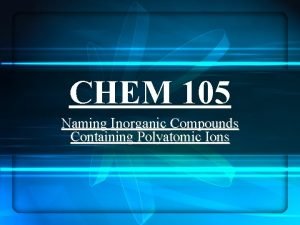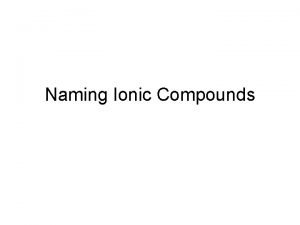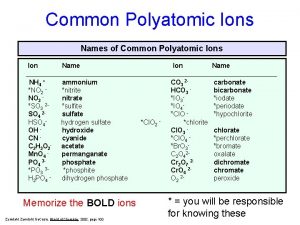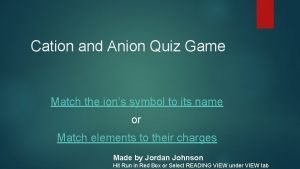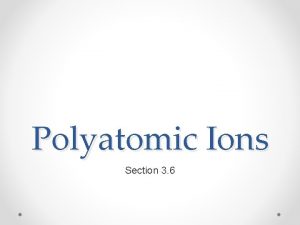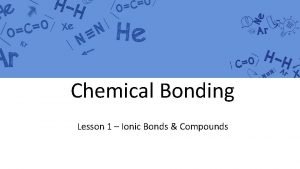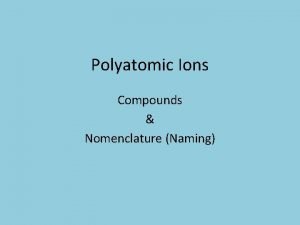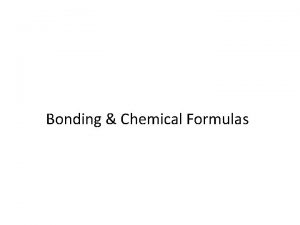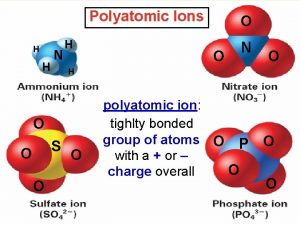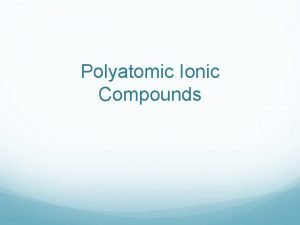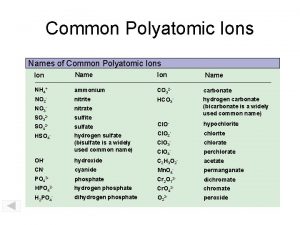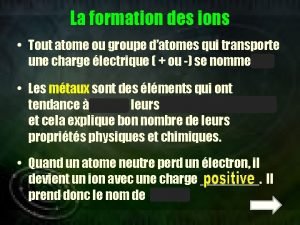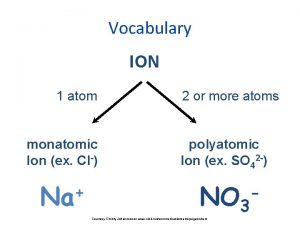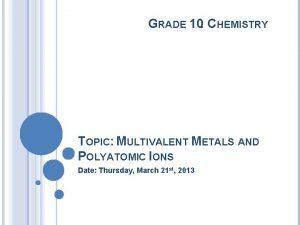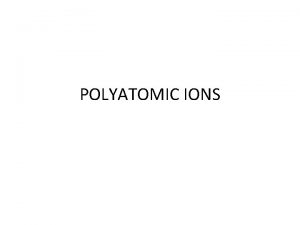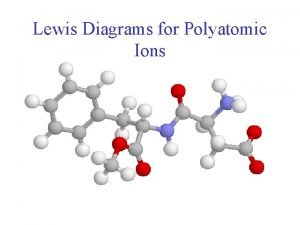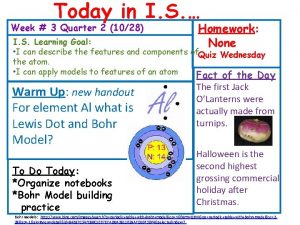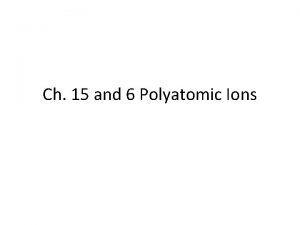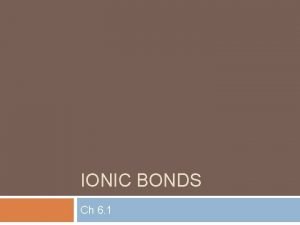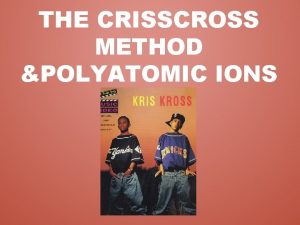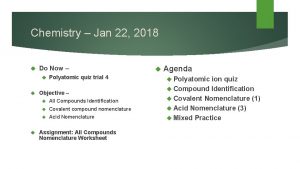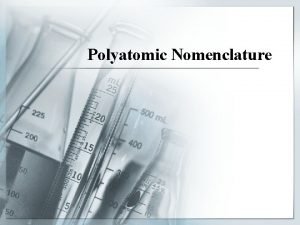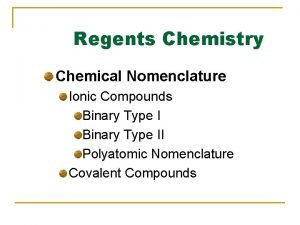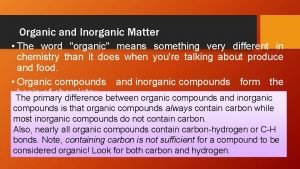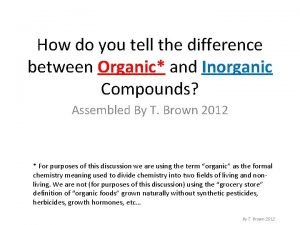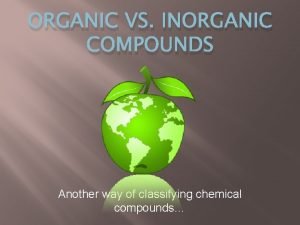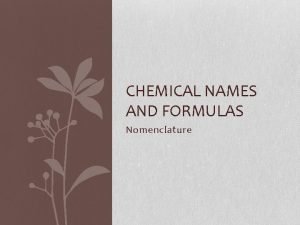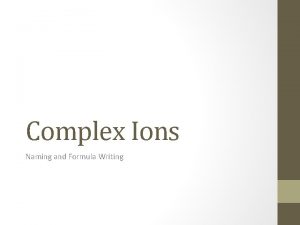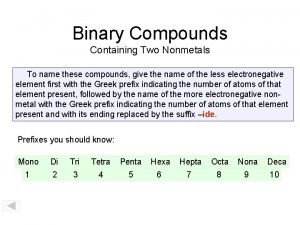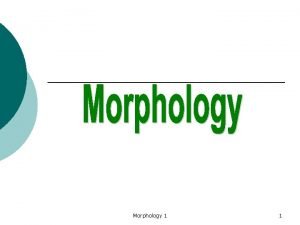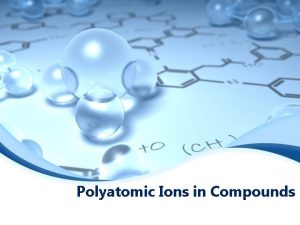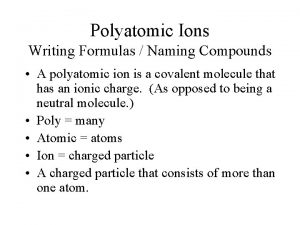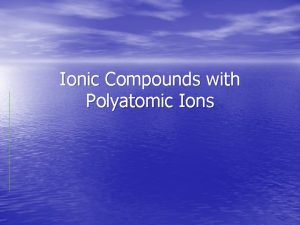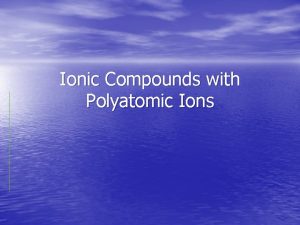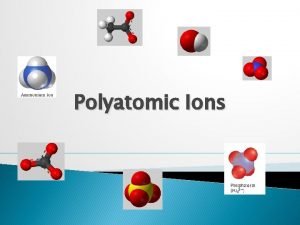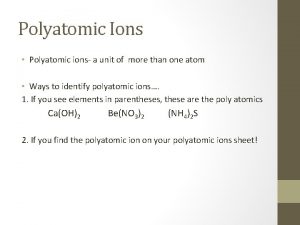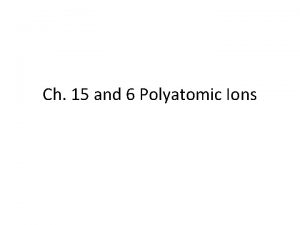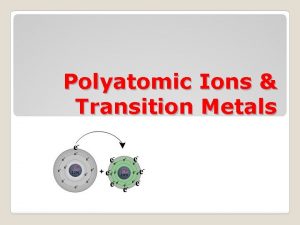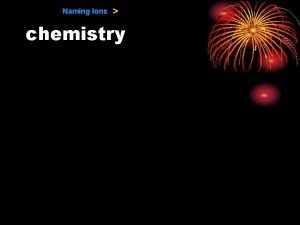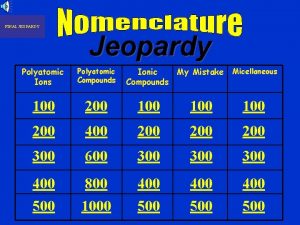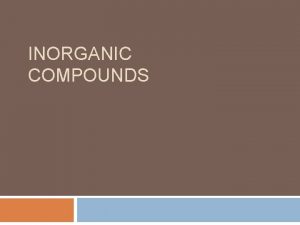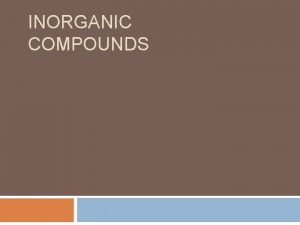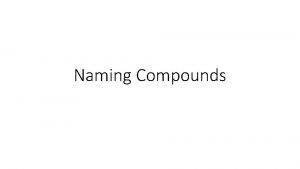CHEM 105 Naming Inorganic Compounds Containing Polyatomic Ions





































- Slides: 37

CHEM 105 Naming Inorganic Compounds Containing Polyatomic Ions

2

A polyatomic ion is an ion that contains two or more elements.

• Compounds containing polyatomic ions are composed of three or more elements. • They usually consist of one or more cations combined with a negative polyatomic ion.

• When naming a compound containing a polyatomic ion, name the cation first and then name the anion.

This is the way the formula is written. The ions are what is actually present.

This is the way the formula is written. The ions are what is actually present.

Prefixes and Suffixes Elements that Form More than One Polyatomic Ion with Oxygen

Anions ending in -ate always contain more oxygen than ions ending in -ite. nitrite nitrate

Anions ending in -ate always contain more oxygen than ions ending in -ite. phosphite phosphate

Anions ending in -ate always contain more oxygen than ions ending in -ite. sulfite sulfate -ate and –ite do not indicate the number of oxygen atoms.

per- denotes anions with more oxygen than the -ate form. chlorate perchlorate

hypo- denotes anions with less oxygen than the -ite form. hypochlorite -hypo means less. chlorate


Four ions do not use the –ate/ite system. hydroxide cyanide hydrogen sulfide peroxide

There are three common positively charged polyatomic ions. mercury(I) hydronium ammonium


Acids

Oxy-acids contain hydrogen, oxygen and one other element. • The other element is usually a nonmetal, but it can be a metal. • Its first element is hydrogen. • Its remaining elements include oxygen and form a polyatomic ion.

Hydrogen in an oxy-acid is not expressed in the acid name. The word acid in the name indicates the presence of hydrogen.

indicates hydrogen sulfuric acid contains hydrogen sulfur oxygen

Anions ending in -ate always contain more oxygen than ions ending in -ite. phosphite phosphate

Naming the Acid Based on the Name of the Polyatomic Ion Ending of Acid ite ous ate ic less oxygen more oxygen

Examples

sulfite sulfurous acid

sulfate sulfuric acid

nitrite nitrous acid

nitrate nitric acid



Writing Formulas From Names of Compounds

A chemical compound must have a net charge of zero.

If the compound contains ions, then the charges on all of the ions must add to zero. ryan likes boys

Write the formula of calcium chloride. Step 1. Write down the formulas of the ions. Ca 2+ Cl. Step 2. Combine the smallest numbers of Ca 2+ - so that the sum of the charges and Cl The cation Theisanion is equals written first. zero. second. (Ca 2+) + 2(Cl-) = 0 (2+) + 2(1 -) = 0 The lowest common multiple The correct formula is Ca. Cl 2 of +2 and – 1 is 2

Write the formula of barium phosphide. Step 1. Write down the formulas of the ions. Ba 2+ P 3 Step 2. Combine the smallest numbers of Ba 2+ 3 - so that the sum of the charges and P The cation The anion is is equals zero. written first. second. 3(Ba 2+) + 2(P 3 -) = 0 3(2+) + 2(3 -) = 0 The lowest common multiple The correct formula is Ba 3 P 2 of +2 and – 3 is 6

Write the formula of magnesium oxide. Step 1. Write down the formulas of the ions. Mg 2+ O 2 Step 2. Combine the smallest numbers of Mg 2+ and O 2 - so that the sum of the charges equals zero. (Mg 2+) + (O 2 -) = 0 (2+) + (2 -) = 0 The lowest common multiple The correct formula is Mg. O of +2 and – 2 is 1

 Ionic compounds containing polyatomic ions
Ionic compounds containing polyatomic ions Table e selected polyatomic ions
Table e selected polyatomic ions The proper chemical formula for auric nitride is
The proper chemical formula for auric nitride is Polyatomic ions game
Polyatomic ions game Polyatomic ions list
Polyatomic ions list Polyatomic ions list with charges
Polyatomic ions list with charges Nick the camel ate a clam supper in phoenix
Nick the camel ate a clam supper in phoenix Polyatomic ion
Polyatomic ion Polyatomic ions sheet
Polyatomic ions sheet Poly atomic ions
Poly atomic ions Polyatomic ionic compound definition
Polyatomic ionic compound definition Ions
Ions Cation polyatomic ions
Cation polyatomic ions Nomor atom cl
Nomor atom cl Ionic compounds worksheet grade 10
Ionic compounds worksheet grade 10 Polyatomic ions list with charges
Polyatomic ions list with charges Ocn- lewis structure
Ocn- lewis structure Polyatomic ions
Polyatomic ions 6 polyatomic ions
6 polyatomic ions Dicarbon tetraoxide
Dicarbon tetraoxide Ionic compounds criss cross method
Ionic compounds criss cross method Polyatomic ions quiz
Polyatomic ions quiz Monatomic ions
Monatomic ions Common polyatomic ions
Common polyatomic ions What do the roman numerals in a cation's name indicate?
What do the roman numerals in a cation's name indicate? Binary vs polyatomic compounds
Binary vs polyatomic compounds Meaning of the word organic
Meaning of the word organic Whats the difference between organic and inorganic
Whats the difference between organic and inorganic Organic vs inorganic compounds
Organic vs inorganic compounds Organic and inorganic compounds experiment
Organic and inorganic compounds experiment What is pharmaceutical inorganic chemistry
What is pharmaceutical inorganic chemistry Importance of organic chemistry
Importance of organic chemistry Naming monatomic ions
Naming monatomic ions Naming ions
Naming ions Complex ion naming
Complex ion naming What is the term for a compound containing two nonmetals?
What is the term for a compound containing two nonmetals? Headless compound
Headless compound Ionic compounds containing transition metals
Ionic compounds containing transition metals
